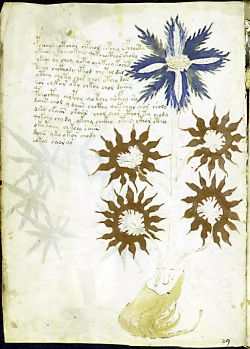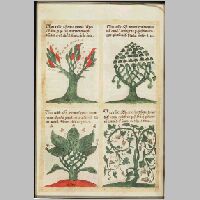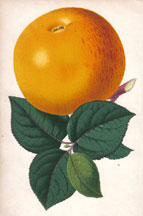I'm guessing that the Apple Lady might like to write about the Voynich manuscript, if the request lines are still open, and she's craving a Peasgood's Nonesuch, and suspects her readers would like the same.
I've never heard of the Voynich manuscript. So, your devoted Apple Lady dons her investigative cap and dives in.
- Briefly, the Voynich manuscript is known as "the world's most mysterious manuscript." It's a very old document that's written in some strange script that seems like a language, or perhaps a code, but nobody knows what the script is and nobody's been able to de-code it.

This is what the script of the Voynich manuscript looks like.
(Image from Nabataea.net)
- Throughout its 235 pages, there are lots of drawings of leaves and plants and sunflowers. There are also big circles with stars in the middle, like maybe a kind of calendar or astrological map. Finally, there are also drawings of groups of naked women, gathered in pools of liquid that then have stems or pipes growing out of them.

Sample of some of the plant drawings
(Image from Nabataea.net)

One of the drawings of big circles with stars in the middle
(Image from NASA's Astronomy Picture of the Day)

One of the pages with drawings of women in a pool
(Image from Richard Shand's Illuminations site)
- Various ideas of what the manuscript might be about include alchemy, astronomy, astrology, medicine, a guide to herbs, some type of Rosicrucian or secret sect's controversial beliefs, and a hoax.
- People have tried to figure out even when the manuscript was first written, using some of the pictures of plants and postulating about what plants they knew existed in what century, but even those attempts are really just guesses, and other people have been able to poke holes in those theories.
- The manuscript is called Voynich after an antiquarian book dealer, Wilfrid M. Voynich, who bought it in 1912. No one knows exactly where he got it from, except that he got it somewhere in Europe. He brought it to people in the United States whom he thought could de-code it and also tell him of its true value.
- A letter that was with the manuscript said that a priest from the Charles University of Prague was sending the manuscript to a Jesuit Priest named Kircher in Rome in the hopes that he could de-code it. That letter was dated 1666. The letter also said that an Emperor from Bohemia, who lived in the late 1500's to early 1600's, used to own it. The letter further said that the Emperor believed that it was written by a famous Franciscan Friar, Roger Bacon, who lived in the 1200's.
- Voynich didn't figure out too much more about the manuscript. He died, the manuscript was handed down through a few people in his family, and then a New York book dealer named Kraus bought it for $24,500. He valued it at $160,000, but he never found anyone who wanted to buy it. Finally, he donated it to Yale University, where it remains to this day, in its Beinecke Rare Book and Manuscript Library.
- Roger Bacon was the author, and he had built a working telescope and a working microscope and was able to see the Andromeda Galaxy as well as cellular structures. The type of microscopes and telescopes that would have been necessary to see these things were absolutely unknown in the 13th century. This proposed solution was disproved in 1931, but some people still think Bacon was the author.
- One guy at the Catholic University in Washington started to transcribe it by hand, making a card index for each of the words and a concordance. He labored at this for years, but then he died and no one knows if he reached any conclusions at all.
- Other people have identified the species of plants and the zodiac symbols, and they have tried translating some of the script, assuming that those words correspond with the names of plants or symbols. But those "translations" make various logical assumptions that haven't been borne out in other parts of the text.
- Others have suggested that the script is possibly abbreviated medieval Latin, Ukrainian, Manchurian, Sanskrit, a Creole version of Flemish, or other known languages. Most of these theories are problematic in that they require the use of characters or words that did not exist in the time frame that the manuscript would have been written.
- Still others have suggested various types of codes, including a polysyllabic cipher and a random cryptology which was used to generate a hoax document. However, various problems exist in the logic behind the proposed codes, such that the codes cannot be applied the same way throughout the document, or that the codes do not take into account that in some ways, the text follows some of the laws of natural language.
The drawings are cool-looking, though.

(Image from Amaranth Publishing)

(Image from Andy Pryke.com)

(Image from someone's Urban Adventure in Rotterdam)
Oh, and by the way, a Peasgood Nonesuch is a type of apple. It grows primarily in Lincolnshire, England. A Peasgood can grow to be enormous, "nearly as big as a boy's head," and is often used in cooking.

You can get a print of this Peasgood Nonesuch from Darvill's Rare Prints for $45.
Sources
Rene Zandbergen, The Voynich Manuscript, 2004
Nabataea.net, The Voynich Question
World Mysteries, Strange Artifacts, Voynich Manuscript
To see photonegatives of manuscript pages from the Yale University Library, go to this site and enter "Voynich"
Lincolnshire countryside access, Cross O'Cliff Orchard, Lincoln
Fruitwise.net, Apple Varieties We Grow, Peasgood's Nonesuch
Wilfrid Voynich married Ethel Boole, daughter of George Boole, the pioneer of mathematical logic for whom Boolean Algebra is named. As "E.L. Voynich" she wrote a number of books, including "The Gadfly," a sort of romantic-nationalist-democratic swashbuckler whose hero fights for Italian independence against the Austrians. It's nnot well-known in the US but was very popular in the USSR, where a ballet version was created, to music by Shostakovich.
ReplyDeleteI wonder what, if any, scientific analysis has been done on inks, pigments, and page material(s), to accurately date its production and consistency?
ReplyDeleteAnalysis of the pigments led researchers some time ago to a best guess of a date of origin. But I couldn't find anyone saying they had conducted a forensic analysis on the document. Probably the folks to own it at Yale wouldn't let you dissolve the paper in some solution for the purposes of accurate dating.
ReplyDeleteFor evidence of changes in the original pigmentation, see http://www.dcc.unicamp.br/~stolfi/voynich/04-07-15-retouching/
I think the key issue for most people, though, is figuring out what it means (cryptology). And Gordon Rugg seems to have hit on what seems to be the currently most-plausible theory: it's a hoax. See http://www.wired.com/wired/archive/12.09/rugg.html
Thanks for your question!
Dig: http://www.plosone.org/article/info%3Adoi%2F10.1371%2Fjournal.pone.0066344
ReplyDelete